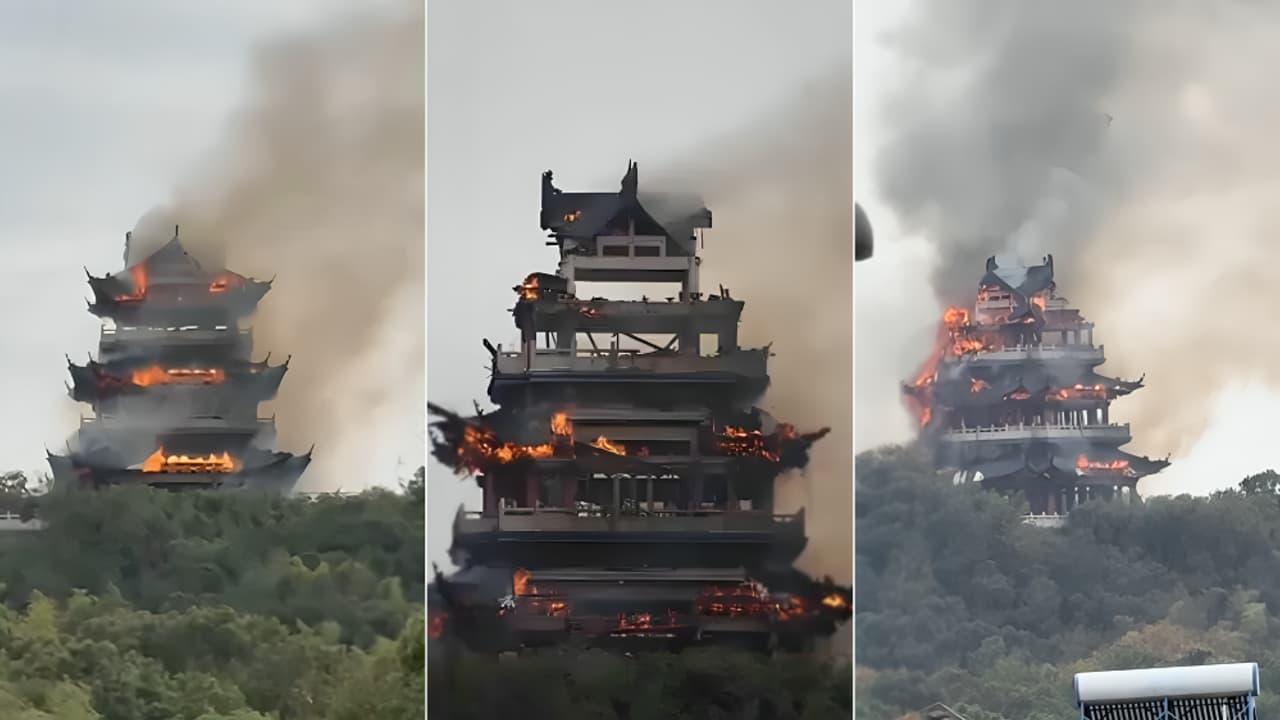A massive fire on November 12 damaged the 1,500-year-old Yongqing Temple in Zhangjiagang, Jiangsu province, one of China’s oldest Buddhist temples. The blaze destroyed a multi-storey pavilion but spared the main structure.
A fire broke out on November 12 at the 1,500-year-old Yongqing Temple in Zhangjiagang, Jiangsu province, raising alarm over the damage to one of China’s ancient religious and cultural landmarks. Flames tore through a multi-storey pavilion within the temple complex, sending up huge plumes of smoke, as local residents gathered outside and firefighters strove to bring the blaze under control.
Scroll to load tweet…
Scroll to load tweet…
Scroll to load tweet…
Several videos shared on social media show the dramatic scene: ornate wooden roofs in flames, thick black smoke billowing into the evening sky, and crowds watching helplessly as the fire raged. According to local authorities, the fire has now been largely contained and, fortunately, no casualties have been reported so far. Initial assessments suggest the blaze began in a replica of an ancient-style building inside the temple grounds. While the main temple structure appears to have survived, the pavilion that was lost held significant heritage value.
Restoration efforts are expected to take several months, officials say, as heritage experts assess the damage and deliberate how best to save and restore the temple complex.
Yongqing Temple: A historic treasure
Yongqing Temple is located at the foot of Fenghuang Mountain (Phoenix Mountain) in Zhangjiagang and is one of the oldest Buddhist temples in the region. According to historical sources, the temple was originally built during the reign of Emperor Datong of the Southern Liang Dynasty around 536 AD, giving it a history of roughly 1,500 years, according to China Daily.
The temple was once among the 480 temples of the Southern Dynasties era (420-589 AD), as noted in a famous Tang Dynasty poem by Du Mu.
Over the centuries it has undergone numerous repairs and additions, yet still retains vestiges of its ancient spiritual and architectural heritage. One of the features making Yongqing Temple special is its ‘three wonders’, which comprises a natural stone wall of great age, a thousand-year-old cypress tree and a massive bodhisattva statue installed in the modern Buddhist Culture Garden.
The temple also houses a hall dedicated to 500 clay arhats and is visited by students who pray for success in exams, underlining its continuing cultural role. The temple is part of the Phoenix Mountain Scenic Area, a national-level 4A tourist attraction, and its history links both religious traditions and local culture.
The significance of Yongqing Temple
Yongqing Temple’s importance lies in several dimensions:
Historical continuity: With origins in the Southern Dynasty period, the temple provides a direct link to China’s early Buddhist period in the south.
Cultural heritage: It preserves rare artefacts and features, such as the thousand-year-old cypress and clay arhats, which reflect Chinese religious art and nature-veneration over centuries.
Local identity and tourism: The temple is a key cultural landmark for Zhangjiagang. Its presence contributes to the city’s tourism appeal and the wider heritage of the Yangtze River Delta region.
Spiritual role: For villagers, students and pilgrims, Yongqing Temple remains an active place of worship and tradition, not just a museum relic.
The fire’s damage to the multi-storey pavilion is a serious loss. While the main temple appears safe for now, officials caution that the structural safety, woodwork, artefacts and internal decorations may be compromised. Restoration work will be delicate, requiring heritage experts, architects experienced in ancient timber structures and funding to rebuild in keeping with the original style.
Local authorities have formed a forensic and investigation team to determine the cause of the fire and to inspect the remaining structures.
Tourism in the Phoenix Mountain Scenic Area may be temporarily affected, with some parts closed for safety and repair. There is also a strong social media reaction that many heritage-lovers and local residents have expressed sadness and concern, underscoring how much Yongqing Temple means to the community.
